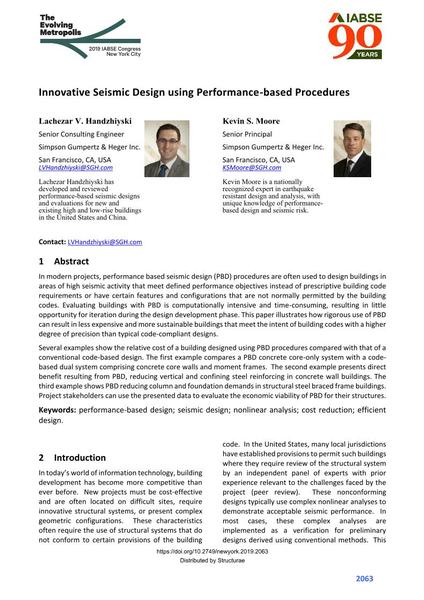Innovative Seismic Design using Performance-based Procedures

|
|
|||||||||||
Bibliographic Details
| Author(s): |
Lachezar V. Handzhiyski
(Simpson Gumpertz & Heger Inc.)
Kevin S. Moore (Simpson Gumpertz & Heger Inc.) |
||||
|---|---|---|---|---|---|
| Medium: | conference paper | ||||
| Language(s): | English | ||||
| Conference: | IABSE Congress: The Evolving Metropolis, New York, NY, USA, 4-6 September 2019 | ||||
| Published in: | The Evolving Metropolis | ||||
|
|||||
| Page(s): | 2063-2068 | ||||
| Total no. of pages: | 6 | ||||
| DOI: | 10.2749/newyork.2019.2063 | ||||
| Abstract: |
In modern projects, performance based seismic design (PBD) procedures are often used to design buildings in areas of high seismic activity that meet defined performance objectives instead of prescriptive building code requirements or have certain features and configurations that are not normally permitted by the building codes. Evaluating buildings with PBD is computationally intensive and time-consuming, resulting in little opportunity for iteration during the design development phase. This paper illustrates how rigorous use of PBD can result in less expensive and more sustainable buildings that meet the intent of building codes with a higher degree of precision than typical code-compliant designs. Several examples show the relative cost of a building designed using PBD procedures compared with that of a conventional code-based design. The first example compares a PBD concrete core-only system with a code- based dual system comprising concrete core walls and moment frames. The second example presents direct benefit resulting from PBD, reducing vertical and confining steel reinforcing in concrete wall buildings. The third example shows PBD reducing column and foundation demands in structural steel braced frame buildings. Project stakeholders can use the presented data to evaluate the economic viability of PBD for their structures. |
||||
| Keywords: |
seismic design performance-based design non-linear analysis cost reduction efficient design
|
||||
